Down here in Mexico, you can smell a good taco stand a mile away. You can also smell a bad one. That's the trouble. Get into a sizeable town like Ensenada and that's about all you smell. If you're lucky: We're here swilling tequila and test-driving tacos because our Kawasaki KLR650 shredded its rear tube on Baja's debris-laden Highway 1. Try finding an extra 17-incher on Sunday in a shanty town. My boyfriend Mauricio already survived a drive up into the hills with a couple locals. He was offered a prostitute and drugs, but somehow, miraculously, came back with a patchable 21-inch tube instead. Too much rubber for a long day on the rim, but good enough to get the KLR and its BMW G650GS contender safely to a hotel somewhere up the road. What was it that Trip Advisor mentioned about the Casa Devertidas?
Maybe it was a warning about the cricket infestation. Our insanely loud, chirping mattress keeps us up all night, allowing us to ponder the pros and cons of the two budget-minded adventure bikes we have shackled to a fence outside.
We've been tooling around on a 2009 KLR650 and G650GS for three days so far, and our opinion-much like the reeking sludge on our boots-has had time to coagulate. First, and somewhat obvious, is the fact that while these two single-cylinder dual-sports may seem a comparative match on paper, they are horse to ox when put to work. Each offers its own advantage, but not necessarily for the same job.
BMW recently released the G650GS, which is essentially the single-cylinder F650GS of yore with a few minor tweaks. Not least are some timely economic incentives, such as the inclusion of BMW's new-generation ABS and heated handgrips in the bike's $7670 base price. The move to the "G" designation is about the company reorganizing its labels. G now describes all single-cylinder models, while F is for the parallel-twins, R for opposed-twins, K for multis, etc. The only thing shoppers might find confounding is that BMW is still using the F650GS moniker for a new entry-level model powered by a detuned version of the 800cc parallel-twin.
So, why would one purchase the single-cylinder GS instead of the more powerful twin? It's all about value and ease of use. If you add in the ABS and heated-grip options that come standard on the G, the F ends up costing roughly $2500 more, and offers only 20 more horsepower, 10 foot-pounds of torque and just a smidgen more suspension travel. For beginning riders, or those on the short side, the G also offers one of the lowest standard seat heights in dual-sport history at 30.7 inches. Order it with the factory-installed low suspension for an additional $175 and seat height drops further, to a squat 29.5 inches. Conversely, you can order the bike with a high seat and raise it to 32.2 inches
Kawasaki's august KLR650 needs no rambling introduction. It's been a favorite in the dual-sport arena since 1987, with only one major overhaul for '08. In stature, it's Lerch-like next to the BMW, its 35-inch-high seat more on par with trailbikes. If you're tall, or an experienced rider of any inseam, that aggressive posture is a call to serious adventure riding. With 7.9 inches of suspension travel up front and an adjustable 7.3 inches in back, all the KLR needs is a set of aggressive tires and it will eat up anything you throw its way-all for only $5599.
Suspension travel on the BMW (6.7 in. front/6.5 in. rear) is nothing to scoff at, and the bike does come with a useful shock-spring-preload handwheel that makes it a cinch to dial in sag. But the G650's shorter, stiffer suspenders are clearly outperformed by the KLR's in even moderately challenging off-road situations. On that playing field, the Kawi is more comparable to BMW's trail-ready F800GS. From the get-go, BMW has made it clear that the G650GS isn't intended for roosting around as much as for attracting new riders who might trundle down some fireroads. And in this situation, it's a sweetheart. For beginners, it feels a lot more manageable because its weight rides low, whereas the KLR's loftiness feels a bit squirrely to the uninitiated, especially while making tight turns at parking-lot speeds.
There is also the ABS factor, which no one can deny is a boon for new riders, and BMW's new-gen analog system possesses smoother-than-ever activation feel. Happily, it's also super-easy to disengage for off-road riding, or once a rider achieves more confidence and better braking control. Apart from the ABS element, we found the KLR's brakes to offer slightly stronger feel.
For anyone with their sea legs, both bikes are masters at daily-driver duty, offering light, neutral steering, predictable tracking and exceptional maneuverability. So, in terms of around-town usability and for-fun cornering, the choice is only relative to a buyer's size and definition of value.
The Kawasaki is simple, like bacon and eggs, right down to the mechanical gauges. It's carbureted, so anyone with a grasp of basic mechanics can probably get it rolling again-that is, as long as you bring better tools than the ones that come onboard. The BMW is more like huevos rancheros with a side of guacamole. It has an impressive tool kit, but the bike, with its fuel injection and extensive onboard electronics, isn't as amenable to roadside repairs. For some, those luxurious amenities will be what sells them on the G650GS-especially if you invest in the natty BMW hard bags, which are insanely easy to install or remove and don't mess with the bike's appearance when stowed. On the downside, the G650's bags don't lock to the bike's frame like those on the R1200GS. Kawasaki doesn't offer accessory panniers for the KLR, but there are a number available from the aftermarket.
Ironically, we found the stock hand guards on the bare-bones KLR actually kept our paws warmer than the G650's fancy heated grips. On the other hand, the BMW's optional centerstand ($125) was the envy of the day at Llantera el Chepa, where we had to wrestle the KLR onto wooden blocks to remove its rear tire. Both bikes come with short windscreens and luggage racks. The BMW's windshield is easier to remove, and you'll want to because it collects grime between the dash and plastic. Both luggage racks are useful, though the BMW's actually enhances the look of the bike and features a convenient, lockable stash box. We also appreciated the G650's flank-mounted fuel filler, which lets you pump gas like you would into your car-a real blessing in California, where the nozzles wear environmentally friendly foreskins. As for fuel efficiency, the injected BMW offers substantially higher mpg, but holds only 4.0 gallons of fuel to the Kawasaki's 6.1 gallons.
Once underway, the Kawasaki is by far the more comfortable to ride, no matter your height. The stock seat remains a butt-burner, but nothing like the plank that came on KLRs for 20 years prior. The BMW's seat is unfortunately canted so that it pushes the rider's hips toward the tank, making even our shortest tester feel cramped. It also allows more engine vibes to seep through, though the taller seat will likely quell some of that.
Of course, at the heart of these two very different dual-sport motorcycles beats a similar single drum, and although engine management varies, both thumpers deliver adequate power smoothly to chain final-drive systems. The KLR has slightly better pull and gearing for aggressive riding, and this particular unit didn't gulp oil the way our previous testbikes have, making us hopeful Kawasaki addressed the ring-seating issue in the '09 models.
Like mahi-mahi to carne asada, these two bikes will find very different consumers. For those weekend adventurers who want the cache of owning a BMW without spending a boatload of cash, the engineering-intensive G650GS is truly a bargain. It's also perhaps the easiest BMW in history to ride. The KLR, however, is like the perfect taco: When you want something cheap, hearty and satisfying, nothing else will do.
BMW G650GS
Dyno
Fuel injection is the obvious advantage here. Despite identical bore and stroke figures, the G650 stomps the KLR, pumping out 9 more horsepower in a smoother, friendlier manner. Torque is up substantially as well.
Ergos
Despite its dual-sport intentions, the GS's ergonomics are street-biased, with a short peg-to-seat distance and long seat-to-bars reach. If you're vertically challenged, the GS is for you: Its seat is 5 inches lower than the KLR's.
Kawasaki KLR650
Dyno
Power isn't the KLR's forte, but it is sufficient to get the job done. Kawasaki's tried-and-true single has been in production for more than 20 years, and what it lacks in brute force it makes up for in reliability.
Ergos
An upright seating position with a commanding view of the trail ahead-that's what you want from a dual-sport. The KLR delivers with a lofty 35-inch-high seat and high, wide handlebar. If you're shorter than 5-foot-10, you'll need a stepladder.










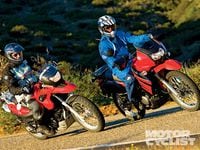
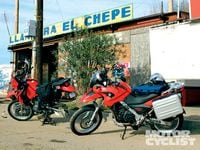

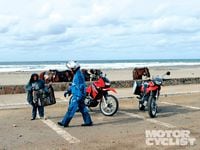
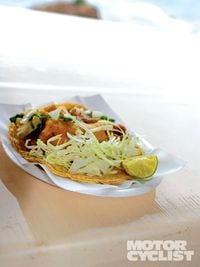




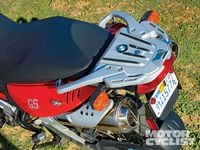

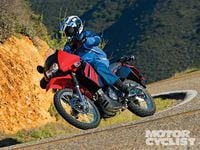
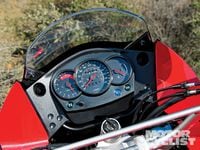
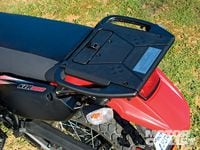
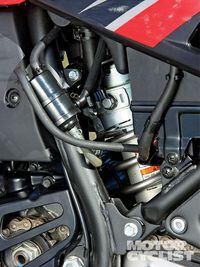
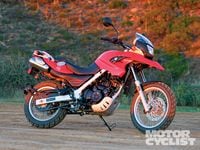
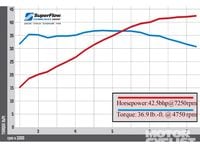

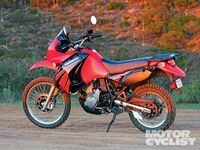

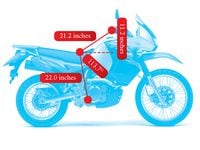
/cloudfront-us-east-1.images.arcpublishing.com/octane/VZZXJQ6U3FESFPZCBVXKFSUG4A.jpg)
/cloudfront-us-east-1.images.arcpublishing.com/octane/QCZEPHQAMRHZPLHTDJBIJVWL3M.jpg)
/cloudfront-us-east-1.images.arcpublishing.com/octane/HXOUJXQWA5HBHGRO3EMJIGFMVI.jpg)

/cloudfront-us-east-1.images.arcpublishing.com/octane/3TIWWRV4JBBOLDVGRYECVVTA7Y.jpg)
/cloudfront-us-east-1.images.arcpublishing.com/octane/KIX5O23D5NAIBGFXBN3327DKZU.jpg)
/cloudfront-us-east-1.images.arcpublishing.com/octane/7GJYDUIPXRGMTMQKN6ONYOLBOU.jpg)
/cloudfront-us-east-1.images.arcpublishing.com/octane/MUQLOVLL2ZDGFH25ILABNBXKTI.jpg)
/cloudfront-us-east-1.images.arcpublishing.com/octane/TNOU5DNE2BC57MFPMGN2EIDXAM.jpg)
/cloudfront-us-east-1.images.arcpublishing.com/octane/GTCXACQGJ5HAPDTGWUQKDEH44E.jpg)
/cloudfront-us-east-1.images.arcpublishing.com/octane/S35YGSEMEZB4BLTDJTSZPF4GLA.jpg)
/cloudfront-us-east-1.images.arcpublishing.com/octane/5UOT6HPX2JFMRJAX6EH45AR4MQ.jpg)
/cloudfront-us-east-1.images.arcpublishing.com/octane/OKWOJWAKP5EP3OACCRRWPCIX2Q.jpg)
/cloudfront-us-east-1.images.arcpublishing.com/octane/2WF3SCE3NFBQXLDNJM7KMXA45E.jpg)
/cloudfront-us-east-1.images.arcpublishing.com/octane/G4MG6OUCJNBSHIS2MVVOTPX65E.jpg)
/cloudfront-us-east-1.images.arcpublishing.com/octane/IIGGWFOTOJGB7DB6DGBXCCMTDY.jpg)
/cloudfront-us-east-1.images.arcpublishing.com/octane/QSTCM6AVEZA5JJBUXNIQ3DSOF4.jpg)
/cloudfront-us-east-1.images.arcpublishing.com/octane/U4I7G625B5DMLF2DVIJDFZVV6M.jpg)
/cloudfront-us-east-1.images.arcpublishing.com/octane/B6XD6LS6IVCQPIU6HXDJSM3FHY.jpg)
/cloudfront-us-east-1.images.arcpublishing.com/octane/ICL63FEDDRDTTMINYICCEYGMDA.jpg)
/cloudfront-us-east-1.images.arcpublishing.com/octane/FCGZHQXRBZFLBAPC5SDIQLVF4I.jpg)
/cloudfront-us-east-1.images.arcpublishing.com/octane/WNOB6LDOIFFHJKPSVIWDYUGOPM.jpg)

/cloudfront-us-east-1.images.arcpublishing.com/octane/X33NU3E525ECRHXLNUJN2FTRKI.jpg)